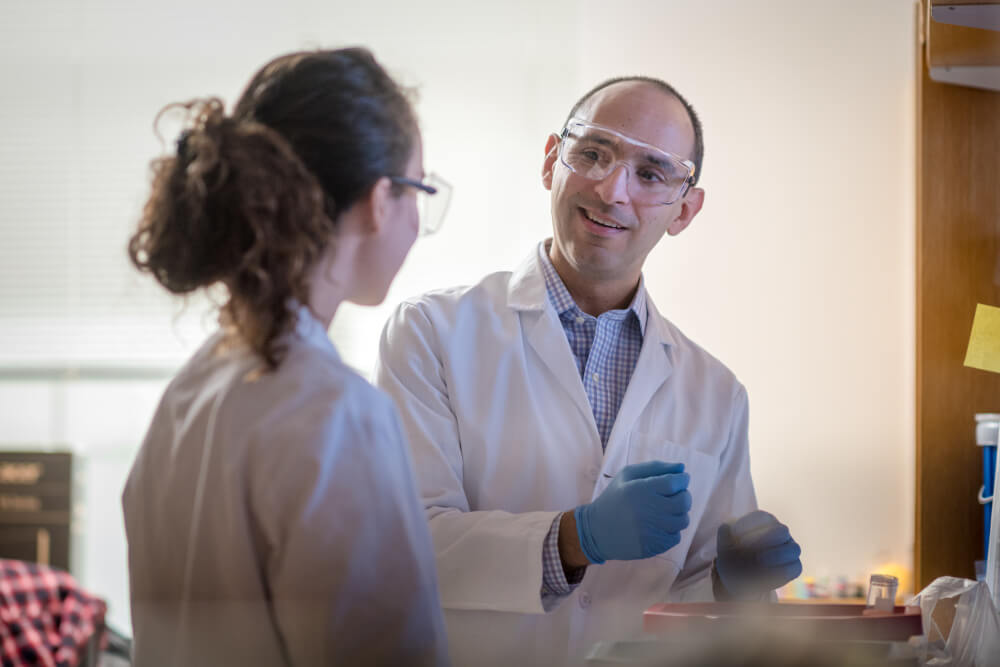Pancreatic cancer cells operate a recycling program that would be the envy of any municipality — but the only beneficiaries are the cells themselves.
All cells in the body recycle minerals and nutrients, removing them from storage and breaking them down them for re-use. But in cancer cells, this process, known as autophagy — literally, “self-eating” — is cranked up to an extreme level.
Scientists have wondered at the reasons for this hyperactivity: what do pancreatic cancer cells gain by it? What, exactly, are they gorging themselves on? If this revved-up recycling is a survival mechanism, are there vulnerabilities within it that could be exploited by precision medicines?
In a recent pair of studies in Cancer Discovery, researchers at Dana-Farber and colleagues at other institutions show that pancreatic cancer cells use a particular form of autophagy — the use and re-use of iron — to sustain their growth and survival. And they single out a protein involved in transporting iron to the cells’ recycling machinery as an inviting target for new therapies.
Together, the findings represent an encouraging development in the quest for targeted therapies able to subdue pancreatic cancer, the third most common cause of cancer-related death in the United States.
The researchers began by asking what pancreatic cancer cells have in their autophagosomes, spherical structures that hold used-up and damaged parts of cells and carry them to another structure called the lysosome, where they’re broken down. Like any recycling bin, the autophagosomes were found to contain a motley jumble of items, but one in particular caught researchers’ attention — a protein called NCOA4, which had never before been spotted in an autophagosome, be it in a normal cell or cancer cell.
Iron-clad evidence
NCOA4’s presence in pancreatic cancer cells offered a clue of what the cells were up to with their hectic autophagy. The protein binds to another protein, called ferritin, that stores iron, and conveys it to the lysosome. There, ferritin is relieved of its load of iron so the iron is available for use by the cell.
“The process of breaking down ferritin to release iron — called ferritinophagy — is universal; it happens in all cells,” says Dana-Farber’s Joseph Mancias, MD, PhD, the senior author of one of the Cancer Discovery papers. “The discovery of NCOA4 in the autophagosome of pancreatic cancer cells, led us to ask whether it can help explain why pancreatic cancer is dependent on autophagy. We know that pancreatic cancer cells require high levels of iron and autophagy. Can NCOA4 provide a link between these phenomena?”

Like prosecutors preparing an indictment, researchers compiled a dossier on NCOA4, looking for evidence of its involvement in ferritinophagy.
From publicly available datasets on pancreatic tumors, they learned that the gene for NCOA4 is more active than in normal pancreatic tissue. From the Broad Institute Cancer Dependency Map – a kind of master list of genetic vulnerabilities within hundreds of cancer cell lines – they found that shutting off the NCOA4 gene slows cancer cell growth in general, but even more so in pancreatic cancer cells.
Mancias’ team reproduced those results in their own experiments, knocking out or knocking down NCOA4‘s activity in pancreatic cell lines and observing a slowdown in cell growth. “The reason for the decrease was a lack of iron availability in the cells,” Mancias relates. “When we added iron to the media the cells were growing in, their growth picked up.”
Researchers then explored whether pancreatic cancer would behave the same way in something more like its native environment than a test tube. In mice engineered to develop the disease in a manner similar to humans, pancreatic cancer usually appears eight to ten weeks after birth. When researchers silenced the NCOA4 gene in the animals, the animals still developed pancreatic cancer, but later in life and lived longer overall, suggesting the gene is important for the onset and progression of the disease.
The case against NCOA4 was sealed when researchers essentially reversed that experiment: in mice genetically programmed to overproduce NCOA4 in tumor-prone cells, there was a dramatic acceleration of pancreatic cancer cell growth, to the point where the animals developed tumors at just one or two weeks of age.
Leading questions
The discovery answered one question but raised another. NCOA4 plays a key role in degrading ferritin, releasing iron into the cell. What do pancreatic cancer cells use the iron for?
To find out, researchers took pancreatic cancer cells dependent on NCOA4 for growth and deactivated the NCOA4 gene. They then did a thorough accounting of the proteins within pancreatic cancer cells with active NCOA4 and in the cell line with deactivated NCOA4 – identifying what types of proteins were present and measuring their abundance.
In the NCOA4-deactivated cells, they found a significant decrease in proteins that need iron in order to perform their functions. Among these were proteins with chunks of iron bound to sulfur – known as iron-sulfur clusters – within them. These proteins are critical for the functioning of mitochondria – structures that generate much of the energy used by cells.
“Pancreatic cancer relies heavily on mitochondria for its growth,” Mancias remarks. The researchers’ findings essentially establish a pathway in which NCOA4 helps degrade ferritin, which frees up iron, which forms clusters with sulfur, which are incorporated into proteins needed to produce energy for the growing cell. This suggests that interrupting this chain of events by blocking NCOA4 with a targeted drug could deplete pancreatic cells of energy and slow their growth.
All the foregoing experiments involved cells or animal models primed to develop pancreatic cancer. Could blocking NCOA4 in established pancreatic tumor cells – like those within patients – be an effective approach to treatment?
To test this idea, Mancias and his associates implanted specially equipped pancreatic cancer cells in mice. The cells carried a mechanism by which the NCOA4 gene could be shut off once they were growing in the animals — a kind of biological remote control. When researchers ordered the gene to cease activity, there was a delay in tumor growth.
The results suggest that targeting NCOA4 might be part of a new treatment approach to the disease but will probably not be sufficient on its own, researchers say.
The second Cancer Discovery paper, for which Dana-Farber researchers are co-authors, suggests a promising approach to combining therapies. The paper provides a mechanistic explanation of why drugs known as KRAS inhibitors can synergize with drugs targeting ferritinophagy to block pancreatic cancer cell growth. The approach is now under study in Mancias’ lab and others.
About the Medical Reviewer

Dr. Joseph Mancias is a radiation oncologist in the Gastrointestinal Oncology disease center at the Dana-Farber Brigham Cancer Center. He specializes in the care of patients with gastrointestinal cancers and runs an independent laboratory at the Dana-Farber Cancer Institute focused on the biology of pancreatic cancer.
He received his medical and graduate degrees as part of the Tri-Institutional Weill Cornell/Rockefeller/Sloan-Kettering M.D.-Ph.D. Program earning a Ph.D. degree from the Weill Cornell Graduate School of Medical Sciences and his M.D. from Weill Cornell Medical College. He performed his internship in Internal Medicine at Brigham and Women’s Hospital followed by a residency in Radiation Oncology in the combined Harvard Radiation Oncology Program. He subsequently completed a research fellowship in pancreatic cancer biology at Harvard Medical School and Dana-Farber Cancer Institute.
His research focuses on critical aspects of the biology of pancreatic cancer including selective autophagy, iron metabolism and therapeutic resistance in order to develop novel therapeutic approaches. His lab takes a comprehensive approach combining biochemical, quantitative mass spectrometry-based proteomic, gene editing, cell biological, and advanced modeling techniques to further our understanding of pancreatic cancer.

This is most interesting as I am a member of a Pancreatic Cancer Cluster family.
Equally, I have been in the National Pancreatic Study with Dr Huma Rana for several years at Dana Farber.
I do not carry any currently known gene mutations for Pancreatic Cancer. I do question if it is a gene issue with our family. We are a family with many having chronic GI issues.
It is enlightening to review such research.